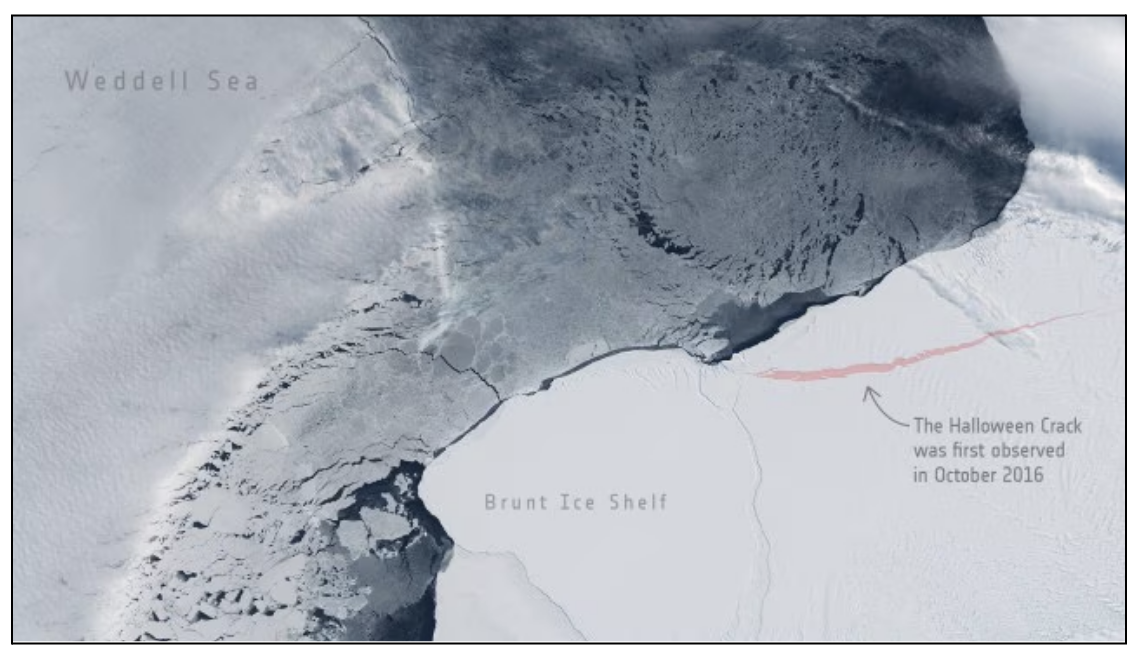News Excerpt:
A large iceberg named A-83 measuring 375 square kilometres, broke off from Antarctica’s Brunt Ice Shelf last week.
More about the news:
- As per the European Space Agency, this was the region’s third significant iceberg calving in the past four years.
- Iceberg A-83 was first spotted off the Brunt Ice Shelf in the eastern Weddell Sea. It broke from a rift known as the “Halloween Crack”.

More about Halloween Crack:
- First spotted on 31 October 2016, the Halloween Crack runs from an area known as McDonald Ice Rumples – which is where the underside of the floating ice sheet is grounded on the shallow seabed. This pinning point slows the flow of ice and fractures the ice surface.
- Location and Formation
-
- McDonald Ice Rumples: The crack originates in this area, where the floating ice sheet's underside is grounded on the shallow seabed. This grounding point, known as a pinning point, slows the ice flow and creates fractures on the surface.
- Geological Impact: The McDonald Ice Rumples are caused by an underwater obstruction where the bedrock rises into the underside of the ice shelf. This results in pressure waves, crevasses, and rifts forming on the ice surface.
- Characteristics of the Halloween Crack
-
- Current Status: The Halloween Crack is presently stable.
- Location: It runs adjacent to the more vulnerable tip of the Brunt Ice Shelf.
- Potential Break-off: The precarious tip of the ice shelf is tenuously held by a narrow ice strip about 600 meters long. If this narrow strip fails, it could lead to the formation of a massive iceberg.
- Potential Impact
- Iceberg Formation: If the ice shelf's vulnerable tip gives way, it is anticipated to generate an iceberg roughly 1750 square kilometers in size. This situation illustrates the dynamic and fragile nature of ice shelves in Antarctica, highlighting the complex interplay between geological formations and ice flow dynamics.
ESA mission and crack detection: The European Space Agency's (ESA) Copernicus Sentinel-1 mission plays a crucial role in monitoring the Brunt Ice Shelf and its evolving cracks, including the Halloween Crack and Chasm 1.
Copernicus Sentinel-1 Mission and Crack Detection
- Copernicus Sentinel-1: The mission is composed of two satellites, each equipped with advanced radar instruments. These instruments provide continuous, all-weather, day-and-night imagery of the Earth's surface.
- Ideal for Polar Monitoring: The radar capability is especially useful for observing the polar regions, which experience prolonged darkness during winter, and areas like tropical forests that are often cloud-covered.
Monitoring the Brunt Ice Shelf
- Radar Imagery: Using radar images, Sentinel-1 has been able to monitor the Brunt Ice Shelf extensively. The animation from Sentinel-1 shows the development of two significant fractures, Chasm 1 and the Halloween Crack, from September 2016 to mid-October 2019.
- Evolution of Cracks: Chasm 1 runs northwards, while the Halloween Crack extends eastwards. Currently, they are only a few kilometers apart. If they intersect, they are expected to create an iceberg roughly the size of Greater London.
Ice Shelf Dynamics and Calving
- Early Observations: Maps from the 1970s reveal that the Brunt Ice Shelf was once a conglomerate of smaller icebergs fused together by sea ice. This indicates the dynamic nature of the ice shelf over decades.
- Glaciological Monitoring: The Brunt Ice Shelf has been under observation by glaciologists for many years, documenting its constant changes and evolution.
Natural Calving Process
- Calving Explained: Calving, the process where chunks of ice break off from the edge of a glacier, is a natural part of an ice shelf's lifecycle. The anticipated iceberg from the Brunt Ice Shelf will be significant but not unprecedented in size for Antarctic icebergs.
- Importance of Monitoring: Regular satellite monitoring provides critical insights into ice shelf behavior, including responses to changes in ice dynamics and variations in air and ocean temperatures. This information is vital for understanding and predicting future changes in these remote and sensitive regions.
Contributions of Sentinel-1
- Continuous Observation: Sentinel-1’s radar instruments offer unprecedented, uninterrupted views of ice shelf changes, which are crucial for tracking and understanding the calving process.
- Enhanced Understanding: The mission’s ability to monitor the ice shelf regardless of weather conditions or light availability greatly enhances the understanding of ice shelf dynamics and the broader implications for global sea levels and climate change.
Conclusion:
The Copernicus Sentinel-1 mission provides invaluable data that enhances our understanding of the Brunt Ice Shelf and its evolving fractures, highlighting the importance of continuous satellite monitoring in the study of polar regions.


